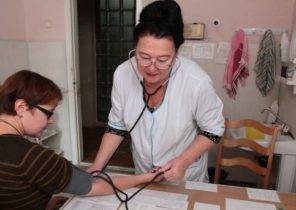Irakli Loladze a mathematician by education, but it is in the biological laboratory he was confronted with a mystery that changed his life. It happened in 1998, when lalaji received his doctorate from Arizona state University. Standing at the glass containers, glowing bright green algae, one biologist said Loladze and half a dozen other graduate students that scientists have found something mysterious in zooplankton.
Zooplankton are microscopic animals floating in the world’s oceans and lakes. They feed on algae, which, in fact, are tiny plants. Scientists have discovered that by increasing the amount of light can accelerate the growth of algae, thereby increasing the supply of food resources for zooplankton and exerting a positive influence on its development. But the hopes of the scientists did not materialize. When researchers began to illuminate the algae, their growth really accelerated. The tiny animals were a lot of food, but, paradoxically, at some point they were on the brink of survival. Increase the amount of food should lead to improving the quality of life of zooplankton, and eventually turned into a problem. How could this happen?
Despite the fact that, formally, Loladze studied at the mathematical faculty, he still liked biology and could not stop thinking about the results of the study. Biologists have some idea what happened. More light made the algae grow faster, but ultimately decreased the content of nutrients required for reproduction of zooplankton. Accelerating the growth of algae, researchers have essentially turned them into fast food. Zooplankton had more food, but it has become less nutritious, and so the animals began to starve.
Loladze used his mathematical background to help measure and explain the dynamics, showing the dependence of zooplankton from algae. Together with colleagues he developed a model that showed the relationship between the food source and the animal, it is independent. They published the first scientific report on this topic in 2000-m to year. But beyond that, the attention of Loladze was confined to the more important question of the experiment: how far does this problem go?
“What struck me was how broad the application have received the results,” recalled Loladze in an interview. Can the same problem to affect the grass and cows? But rice and humans? “The moment I began to think about the power of the people has become a turning point for me,” said the scientist.
In the world outside of the ocean, the problem is not that the plants suddenly start to receive more light: for many years, they consume more carbon dioxide. Both plants need for growth. And if more light leads to a fast-growing, but less nutritious “fast vodnym” algae with a poorly balanced ratio of sugar and nutrients, then it would be logical to assume that the increased concentration of carbon dioxide can have the same effect. And it can affect plants all over the planet. What might this mean in relation to those plants which we eat?
Science just didn’t found Loladze. Yes, the fact of increasing carbon dioxide levels in the atmosphere were already well known, but the scientist was amazed at how little research on the impact of this phenomenon on edible plants. For the next 17 years, while continuing his mathematical career, he carefully studied the scientific literature and data that we could find. And the results seemed to be pointing in one direction: the effect of fast food, which he learned in Arizona was manifested in the fields and forests around the world. “As the level of CO₂ continues to rise, every leaf and every blade of grass on Earth produce more and more sugars, — explained Loladze. — We witnessed the biggest in the history of stuffing of carbohydrates in the biosphere — stuffing, diluting other nutrients in our food resources”.
The scientist has published data collected just a few years ago, and they quickly attracted the attention of small, but concerned group of researchers that raise troubling questions about the future of our food. Would carbon dioxide have on human health have not studied the influence? It seems that the answer is positive, and looking for evidence of Loladze and other scientists had to ask the most pressing scientific questions, including this: “How difficult is it to conduct research in the field that does not yet exist?”
In the field of agricultural research the news that many important foods become less nutritious, did not make the news. Measurement of fruits and vegetables indicate that their content of minerals, vitamins and protein decreased significantly over the past 50-70 years. Researchers believe that the main reason is quite simple: when we breed and select crops, the main priority for this is higher yield and not nutritional value, while varieties producing higher yields (be it broccoli, tomatoes or wheat) and is less nutritious.
In 2004, the result of a thorough study of fruits and vegetables revealed that all from protein and calcium to iron and vitamin C decreased significantly in most horticultural crops since 1950. The authors came to the conclusion that this is mainly due to the selection of varieties for further breeding.
Loladze in the company of several other scientists suspect that it goes beyond that, and that maybe the atmosphere is changing our food. Carbon dioxide is necessary for plants as well as people — oxygen. The level of CO₂ in the atmosphere continues to grow — in an environment of increasingly polarized discussions about climate science, no one comes to mind to dispute this fact. Before the industrial revolution the concentration of carbon dioxide in the Earth’s atmosphere was about 280 ppm (Engl. parts per million, ppm is a unit of measurement of any relative values, equal to 1·10-6 from baseline approx. ed.). Last year this value reached the level of 400 ppm. Scientists project that in the coming century we are likely to reach 550 ppm, which is two times more than it was in the air when the Americans just started to use tractors in agriculture.
Those who are interested in breeding plants, such dynamics may seem positive. Moreover, it was covered by the policy, justifying its indifference to the consequences of climate change. Republican Lamar Smith, Chairman of the Committee of the U.S. house of representatives on science, recently claimed that people should not worry about increasing carbon dioxide levels. According to him, it’s good for plants and what is good for plants, good for us.
“The higher the concentration of carbon dioxide in our atmosphere will contribute to photosynthesis, which in turn will lead to increased growth of plants;- wrote a Republican from Texas. — Food will be produced in large volume, and their quality will be better.”
But, as shown by the experiment with the zooplankton, larger volume and better quality do not always go hand in hand. On the contrary, between them can be established inverse relationship. Here’s the explanation for this phenomenon is given to the best scientists: the increasing concentration of carbon dioxide accelerates the process of photosynthesis — the process that helps plants to process sunlight into food. As a result, their growth is accelerating, but along with this they also begin to absorb more carbohydrates (e.g., glucose) to the detriment of others we need nutrients such as protein, iron and zinc.
In 2002, continuing her studies at Princeton University after defending doctoral thesis, Loladze published in the leading journal Trends in Ecology and Evolution is a thorough research paper in which it was argued that increasing levels of carbon dioxide and human nutrition is inextricably linked to the global changes the quality of the plants. In the article, Loladze complained about the lack of data among thousands of publications on the plants and raising the level of carbon dioxide, he was able to find only one in which special attention was paid to the influence of gas on the nutrient balance in rice culture, for the harvest which rely on billions of people. (Article published in 1997, dedicated to the fall of the level of iron and zinc in rice).
In his article, Loladze first showed the effect of carbon dioxide on plant quality and nutrition. However, the scientist had raised more questions than found answers, rightly arguing that the study still many gaps. If changes in nutritional value occur at all levels of the food chain, they need to learn and measure.
As it turned out, part of the problem was in the research world. For answers of Loladze required knowledge in the field of agronomy, nutrition and physiology of plants, thoroughly spiced with math. With the last part can handle, but at that time he was just beginning his scientific career, and the math Department wasn’t interested in solving the problems of agriculture and human health. Loladze struggled trying to get funding for new studies and at the same time continued to maniacally collect all possible data already published by researchers from around the world. He went to the Central part of the country, the University of Nebraska-Lincoln, where he was offered the post of assistant Professor. The University is actively engaged in research in the field of agriculture, which gave good prospects, but lalaji was the only teacher of mathematics. As he explained, he can continue his research if he will Finance them. But he continued to fight. In the allocation of grants at the Department of biology he was denied due to the fact that in his application too much focus on the mathematics, and the Department of mathematics is due to biology.
“Year after year I received one refusal after another, recalls Loladze. — I was desperate. I think people did not understand the importance of research.”
This question was left not only in mathematics and biology. To say that the decrease in the nutritional value of main crops due to the increase in concentration of carbon dioxide is poorly studied — to say nothing. This phenomenon is not discussed neither in agriculture nor in the field of health and nutrition. Exactly.
When our correspondents contacted the experts on nutrition to discuss the research topic, almost all of them were very surprised and asked where you can see the data. One leading scientist from Johns Hopkins University answered that question quite interesting, but admitted that he knows nothing about him. He referred me to another specialist, who also first heard about it. The Academy of nutrition and dietetics, the Association that unites a huge number of experts on nutrition, helped me to contact the nutritionist Robin Foroutan, which also was not familiar with the study.
“This is really interesting, and you’re right, few people know,” wrote Forutan by reading some works on this topic. She also added that she would like to further explore the issue. In particular, she is interested in how even a minor increase in the number of carbohydrates in plants can affect human health.
“We don’t know what in the end may cause a small variation of carbohydrate content in food, — said Foroutan, noting the fact that the universal tendency to consume more starch and carbohydrates seems to have some relevance to the increased incidence of diseases related to nutrition such as obesity and diabetes. — How changes in the food chain can impact this? While we can’t exactly say.”
We were asked to comment on this phenomenon one of the most famous specialists in this region — Marion Wore, a Professor at new York University. Wore deals with issues of food culture and health. At first it’s all quite skeptical, but promised to examine in detail the available information on climate change, and then took another position. “You have convinced me, — she wrote, also expressing concerns. — It is not clear whether the reduction of nutritional products due to increased concentration of carbon dioxide can significantly affect human health. We need a lot more data.”
Kristi EBI, a researcher from the University of Washington, examines the connection between climate change and human health. She is one of the few scientists in the U.S. who are interested in the possible serious consequences of changing the amount of carbon dioxide, and mentions it in every speech.
“Too many unknowns, — Mrs. eby. For example, how do you know that the bread is no more nourishing minerals that were in it 20 years ago?”
According to eby, the relationship between carbon dioxide and meals immediately became apparent to the scientific community precisely because it took them quite some time to begin to seriously consider the interaction of climate and human health in General. “That’s the way it usually looks, says abi, the threshold of change.”
In the early work of Loladze was raised a serious questions that are difficult, but quite possible to find answers. How does increasing the concentration of CO₂ in the atmosphere affects the growth of plants? What percentage of influence of carbon dioxide on the falling nutritional value of products relative to the share of other factors such as growing conditions?
To conduct an experiment at the scale of a farm to find out how carbon dioxide affects plants is also difficult, but doable task. Researchers use a method that transforms the field into a real laboratory. Today is the perfect example of this is the experiment “the Enrichment of carbon dioxide in the open air” (free-air carbon dioxide enrichment, abbreviated to — FACE). During this experience, scientists outdoors create large-scale devices that spray carbon dioxide on plants in a certain area. Small sensors monitor the level of CO₂. When too much carbon dioxide out of bounds, a special device sprays a new portion to the level remained constant. Then the scientists can directly compare these plants with those grown under normal conditions.
These experiments showed that plants growing in conditions of high content of carbon dioxide, undergo significant changes. So, the group of C3-plants, which includes nearly 95% of the plants of the Earth, including those that we eat (wheat, rice, barley and potatoes), there was a decrease in the number of important minerals — calcium, sodium, zinc and iron. According to the predictions of plant responses to changes in the concentration of carbon dioxide already in the near future the quantity of these minerals will decrease on average by 8%. The same data indicate a decline, sometimes quite significant, protein content in C3-crops — from wheat and rice by 6% and 8% respectively.
This summer, a group of scientists published the first work in which attempts were made to assess the impact of these changes on the Earth’s population. Plants are an important source of protein for people in the developing world. According to researchers, by 2050, 150 million people are at risk to experience a shortage of protein, especially in countries such as India and Bangladesh. The researchers also found that 138 million will be at risk because of lower quantities of zinc, vital for the health of the mother and child. According to their calculations, more than 1 billion mothers and 354 million children live in countries which are projected to decrease the amount of iron in the diet that may exacerbate the serious risk of widespread anaemia.
Such forecasts ignore the U.S., where the diet of most of the population is diverse and contains enough protein. However, the researchers noted an increase in the quantity of sugar in plants and fear that if these rates continue, obesity and problems with the cardiovascular system will become even greater.
The Ministry of agriculture also makes a significant contribution to the study of the relationship of carbon dioxide with the nutritional value of plants. Lewis Ziska, plant physiologist from the agricultural research Service in Beltsville, Maryland, wrote a number of works on nutrition, which examined in detail some of the issues raised by Loladze 15 years ago.
Ziska developed a more simple experiment for which it was not required to grow plants. He decided to study the nutrition of bees.
Goldenrod is a wild flower that many consider a weed, but it is extremely important for bees. It blooms in late summer, and its pollen is an important protein source for these insects during the harsh winter. People never grow goldenrod and did not create new varieties, so over time, it has not changed much, unlike corn or wheat. In the vast archives of the Smithsonian institution holds hundreds of samples of goldenrod, the earliest Dating back to 1842. This allowed Ziska and his colleagues to see how the plant has changed since that time.
The researchers found that since the industrial revolution, the protein content in the pollen of goldenrod fell by one-third, and this decline is closely related to the increased concentration of carbon dioxide. Scientists have long tried to ascertain the reasons for the decline of populations of bees around the world — it may be bad for the crops for pollination they need. In their work Zizka suggested that the reduced protein in the pollen before winter may be another reason why bees difficult to survive in the winter.
The scientist is worried that the impact of carbon dioxide on plants studied from a lack of speed, given the fact that changing methods of farming may take a long time. “We do not have to intervene and begin to use traditional methods to correct the situation, — said Siska. — You will need 15-20 years to the results of laboratory studies can be applied in practice”
Found Loladze and his colleagues, a new comprehensive interdisciplinary issues can be quite complex. The world is full of plant physiologists studying crops, but they are mostly concentrated on the study of factors such as yield and insect pests. It has nothing to nutrition. The experience of Loladze, departments of mathematics are not particularly interesting food products as objects of study. And the study of living plants is a long and expensive: in the course of the experiment FACE to obtain enough data, it will take several years and serious funding.
Despite the difficulties, scientists are becoming increasingly interested in these issues, and in the next few years they might be able to find the answers. Siska and Loladze, who teaches mathematics at the College of health Sciences Bryan in Lincoln, Nebraska, together with a group of scientists from China, Japan, Australia and the USA are working on a major study of the influence of carbon dioxide on the nutritional properties of rice, one of the most important agricultural crops. In addition, they study the change of amount of vitamins, important nutrients, which up to the present time almost done.
Recently, researchers from the Ministry of agriculture of the USA conducted another experiment. To find out how a higher level of CO₂ affects crops, they took samples of rice, wheat and soybeans 50-60 years and drop them off on land, where many years ago, other scientists were growing the same varieties.
On the research field of the U.S. Department of agriculture in Maryland, scientists conducting experiments on bell peppers. They want to determine how the amount of vitamin C with increased concentration of carbon dioxide. They also study the coffee to understand whether there is any amount of caffeine. “Questions are many — shared Siska showing research complex in Beltsville. Is only the beginning.”
Lewis Ziska party a small group of scientists who try to evaluate the changes and determine how they will affect the person. Another key character of this story — Samuel Myers, a climatologist at Harvard University. Myers is the head of the world health Alliance (Planetary Health Alliance). The organization aims to re-unite the climatology and health. Myers is convinced that the scientific community has paid insufficient attention to the relationship of carbon dioxide and nutrition, which is only part of a much larger picture of how these changes can affect the ecosystem. “This is just the tip of the iceberg — says Myers. We had problems getting people to understand how much they should have no issues.”
In 2014, Myers together with a group of scientists published a major study in the journal Nature, which addressed the key crops grown at several sites in Japan, Australia and the USA. In their composition there was observed a decrease of protein, iron and zinc due to increased concentration of carbon dioxide. First publication attracted the real attention of the media.
“It is difficult to predict how global climate change will affect human health, but we are ready for the unexpected. One of them is the relationship of increasing the concentration of carbon dioxide in the atmosphere and reduce the nutritional value of C3 crops. Now we know about it and can predict further development of events,” the researchers write.
In the same year, actually on the same day, Loladze, at that time taught mathematics at the Catholic University of Daegu in South Korea, has published its own article — with data that he collected for over 15 years. This is the largest study of increasing concentration of CO₂ and its effects on the nutritional value of plants. Loladze usually describes the science of plants as “noisy” — as in scientific jargon, the scientists called the area that is full of complex disparate data that seem to be “noise”, and through this “noise” is impossible to hear the signal, you need. It’s a new layer of data was finally large enough to detect the desired signal through the noise and discover the “hidden shift”, as he called him a scientist.
Loladze found that his theory 2002, or rather a strong suspicion that he had expressed, was true. The study involved nearly 130 varieties of plants and more than 15 000 samples, obtained in experiments over the past 30 years. The total concentration of such mineral substances as calcium, magnesium, sodium, zinc and iron, fell on average by 8%. The amount of carbohydrates relative to the amount of minerals increased. Plants, like algae, have become fast food.
Remains to be seen how this discovery will affect man, the main diet of which is plants. Scientists who are immersed in the subject, will be forced to overcome various obstacles: the slow pace and invisibility research, the world of politics, where the word “climate” is enough to stop any conversation about funding. You will need to build a brand new “bridges” in the world of science — about Loladze said with a grin in his work. When the article finally published in 2014, in application of Loladze have included a list of all failures in financing.







